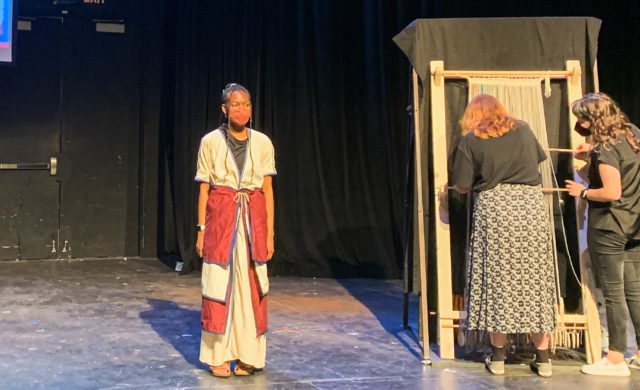By Emma Weidmann | Staff Writer
Students attended a short lecture on Tuesday about the ancient Minoan people of the island of Crete, learning about their history, culture and how they made their hand-woven linen garments. There was also a live demonstration of weaving. With this activity, Dr. Jerolyn Morrison from the Department of Art and Art History and Theatre Arts professor Sarah Mosher presented a unique and interactive Creative Arts Experience.
According to Morrison, a lecturer of art history, archeologists and art historians divide the history of the Minoans, whose name comes from the Cretan king Minos, into three periods — the early, middle and late Bronze Age, approximately 5,000 years ago.
Minos in Greek mythology was known for sending seven men and seven women into the Labyrinth to be eaten by the Minotaur, a creature with the head and tail of a bull and the body of a man.
“The Minoan people were seafarers and traders,” Morrison said. “Some scholars describe Crete as a mini continent. It has cliffs, beaches and high snow-capped mountains.”
The Minoan people were renowned for their craftsmanship, weaving, pottery and unique purple dye made from Murex snail shells, an incredible status symbol for the time. This boosted the flourishing commercial economy of the island.
“The Minoans weren’t isolated in the world,” Morrison said. “They had neighbors that were very influential to the east, to the south and to the north.”
Mosher said the Minoans had a special connection to the land.
“They really felt the scarcity of resources and how much work it took to create things,” Mosher said. “Because they had that knowledge, they were much more likely to respect the things they did have and see them as valuable and to be cared for.”
Crafting textiles in the ancient world was extremely labor and time-intensive. One garment could take weeks or months to create from weaving to construction.
Mosher continued the lecture with a more in-depth explanation of the Minoan style of weaving itself. Minoan garments tended to be more intricate than others of the time, as well as draped on the figure a different way.
“There was a lot of debate for many years on the different garments that were worn and how,” Mosher said. “But the best way we found was to actually do the work to recreate them.”
Students were able to attempt to weave the Minoan way on a period-accurate replica loom. The loom was constructed of a large wooden frame with several vertical threads weighed down to create tension, and a horizontal thread that would be weaved in and out of the vertical threads to eventually create one large panel of fabric.
As a live example of the finished product, a student modeled a full Minoan outfit that was planned and constructed by other students within the theater department. The outfit was just as Mosher described – layered, draped and full of rich colors.
Mosher said modern people have a lot to learn from the ancient world. Throughout history, clothing was an investment, used until it pulled apart at the seams, but in today’s consumerist society, clothing has become disposable.
“I think that there’s a marriage between technology and sustainability,” Mosher said. “But I think that people learning how to mend their own clothing and how to build their own clothes could be really beneficial so that we could see less waste happening.”




